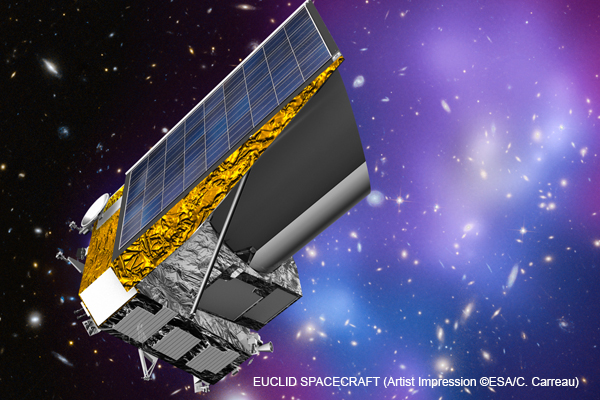October 2015
HPS Space News
On September 30th, HPS welcomed a VVIP-delegation of German and Bavarian space policy at its HQ-premises in Munich. Dr. Gerd Gruppe, head of space management and member of the executive board of DLR was accompanied by DLR´s head of SME-policy, Uwe Soltau, and Bernd Buchenberger, Senior Manager space and aerospace at the Bavarian ministry of economy.
Munich as well as Berlin pay special attention to the sector of space-SME, since SME are expected to serve as pacemakers in the first front of technological innovation. In this respect, space-tech expert HPS is especially in focus, since the company is the only German SME with a subsidiary in Europe representing today the long vacant position of the „M“ in space-SME. In addition, its managing director and owner Dr. Ernst Pfeiffer acts towards politics and business as spokesman of all German space SME organized in the AKRK-Committee.
Accordingly, the delegation was especially interested in the company´s new ready-to-market products – innovations which play a vital role in the German space agency´s new „component initiative“ – as well as in first hand information about important aspects of international cooperation like between HPS Germany and its subsidiary HPS Lda., Portugal.
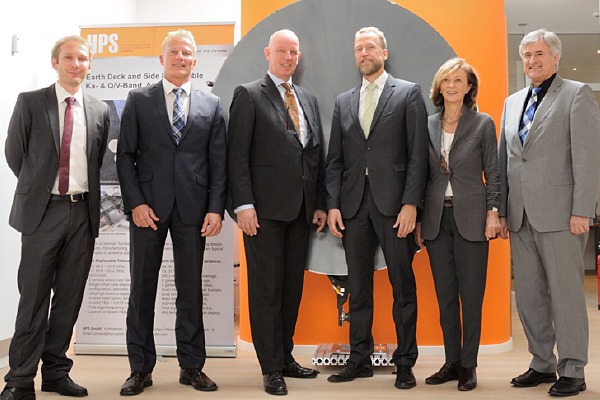
Dr. Gruppe personally pushes the German „component initiative“ with high priority in the firm belief that the German space industry urgently needs to define its own answers to challenges arising from the advent of completely new players like Google on the hitherto „closed shop market“ of space technology. According to Gruppe, „components“ form the central element: small, serially produced, very cost effective, and innovative units which more than ever before allow space to become an integrative and pacemaking part of daily life in business and society.
Together with HPS shareholder Sigrid Klett, former co-owner of the Munich based space company Kayser-Threde, Ernst Pfeiffer introduced the latest HPS-developments, like
- the rapid deployable ground antenna URDA for high-rate data transmissions; the antenna can be carried and operated even offroad by just one person
- an innovation with highest potential for serial production with a spectrum of target customers ranging from TV-correspondents to civil safety and military security personnel
- the Ka-band Dual Gridded Reflector developed by HPS for very stringent mass requirements
- the Q/V-band Feeder Link Top Deck Antenna as a component of future telecom satellites
- the 1.6-m antenna reflector for Ka- and Q/V-band applications – an innovation supported by DLR
- gold plated tungston meshes for large deployable antennas, developed in cooperation with companies and universities in the Bavarian „textile triangle“
- the HPS-development of serially manufactured electronic boxes based on CFRP.
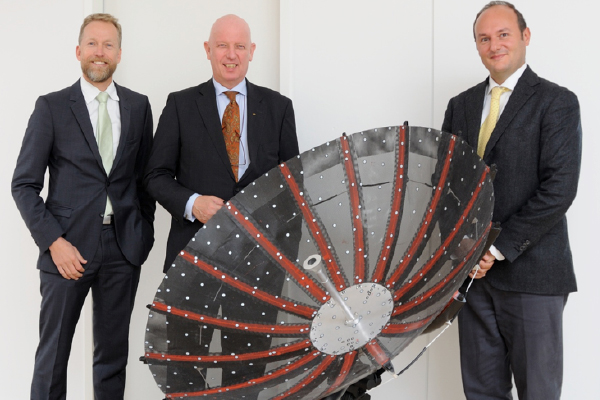
Peter Rauhut, CFO and also co-owner of HPS finally presented the full picture of the business situation of the enterprise growing at high speed since its foundation 15 years ago. In particular, he outlined the enormously positive growth impulses generated by the successful MLI-production of the Portugese subsidiary.
Ernst Pfeiffer outlined the importance of combining a top-quality serial production in Portugal at prices unparalleled with continuous development of new products in Germany in order to win and keep the support of banks accompanying the company´s growth even at fast pace. He also stressed the fact that the obviously strong support by politics in Bavaria and Berlin serves as yet another important cornerstone of trust towards HPS in the financial sector. There is enough room for yet further growth through innovations that lead to serially manufactured products, as an example Pfeiffer hinted at a soon upcoming development of GTO-satellite antennas for the transmission of Galileo-data.
Impressed by the dynamics, the technology and the company culture at HPS the delegation agreed to arrange for successive meetings on yet more detailled subjects in the near future.
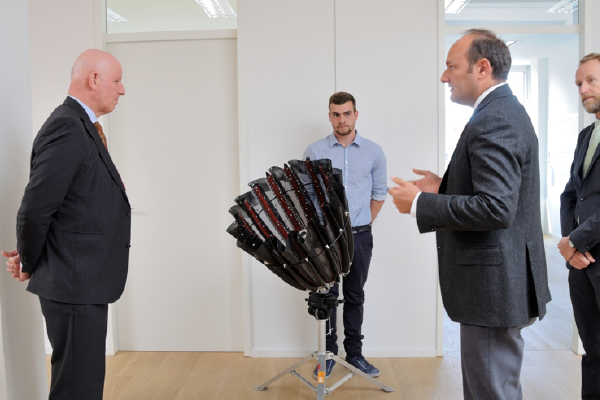
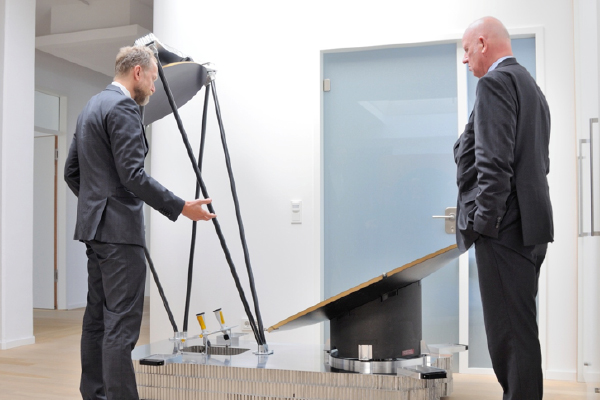
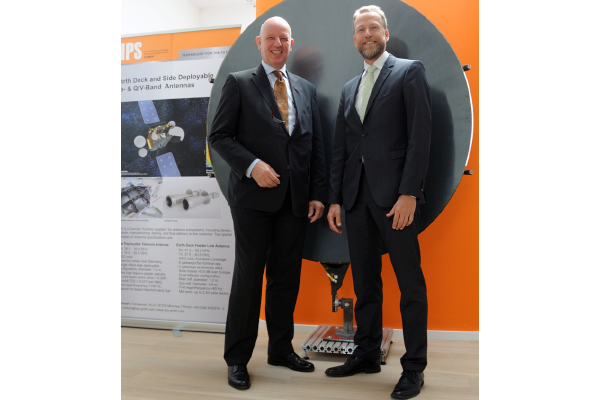
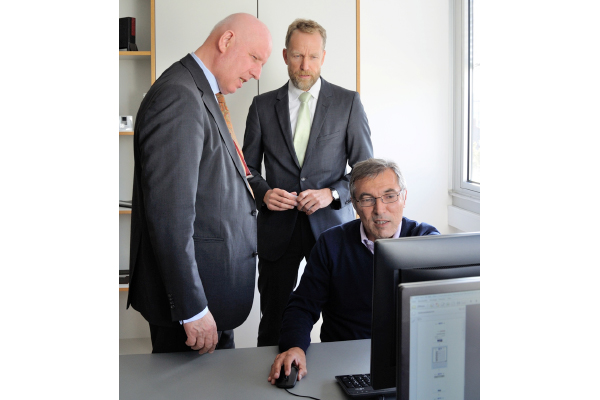
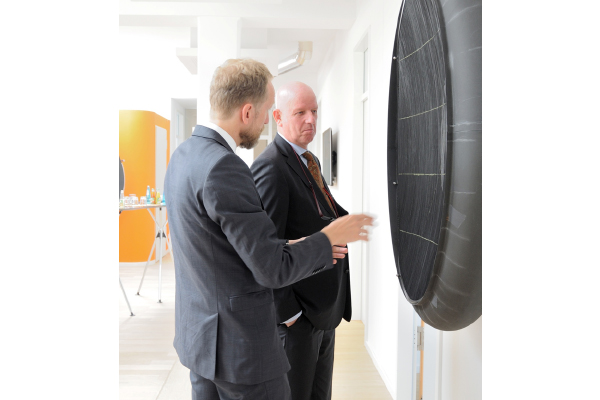
Januar 2015
Under the auspices of the German ministry of economy and energy and DLR Germany had decided to entrust a team of SME-companies under the lead of RWTH-Aachen and several other highly renowned institutes with studies about mission profiles and potentials based on large deployable antenna (LDA)-applications, named SMERALDA (SME´s Radar and Large Deployable Antenna). HPS, the mid-sized antenna specialist and leading space-subsystem manufacturer, was responsible for the central LDA-part of the project that provided a respective concept for a small-scale-mission using a 5-meter LDA.
The study was successfully finished mid December 2014 and presented to a large audience at the German Space Agency in Bonn including to one of DLR’s directors Mr. Christoph Hohage.
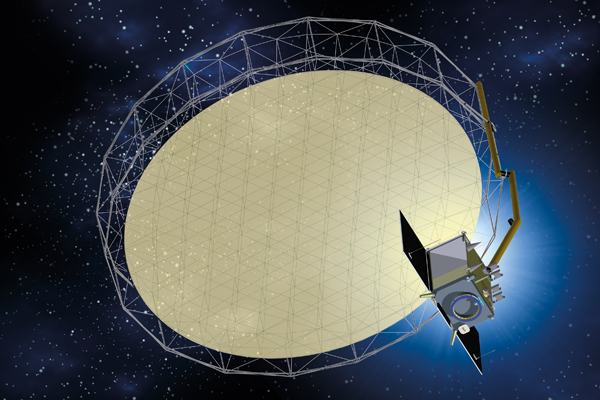
Satellite Communications – Strategic Technology behind Germany´s Economy and Growth
April 2015
Practically no other space-technology provides so much impact on the future development of competitive knowledge- and information-societies like satellite communications. That is why the German ministry of economy and energy and DLR invited the leading companies in this field to the annual satcom-conference from March 25th to 26th in Bonn.
Prominently present among large system integrators (LSI) and small product suppliers (SME): HPS, the mid-sized antenna specialist and leading space-subsystem manufacturer. The Munich based R&D-division of HPS has welcome professionals at its attractive display centering around the company´s latest developments in the field of Q/V-band antennas, multilayer insulation (MLI) and large deployable antennas (LDA) and offered lectures about Q/V-band technologies at HPS as well as on its Ka-band antenna of Heinrich Hertz satellite.
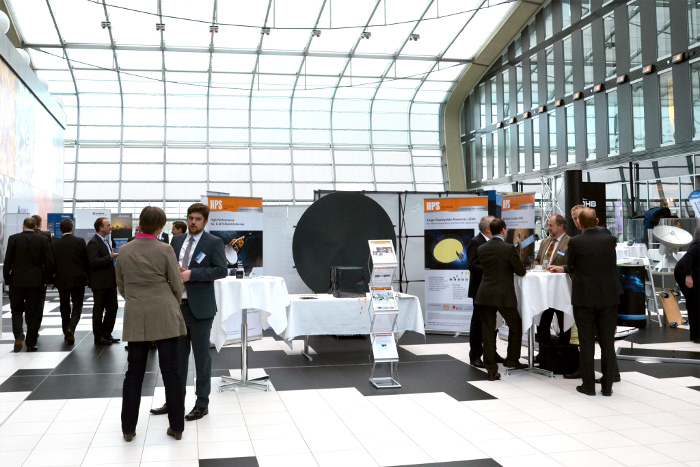
Q/V-Band Feeder Link Antenna Successfully Tested
Mai 2015
During May 2015 a large top deck feeder link antenna (Gregorian configuration, main reflector diameter: 1200 mm, sub-reflector diameter: 700 mm) working in Q/V-Band (Tx: 37.5 – 40.5 GHz, Rx: 47.2 – 50.2 GHz) has been successfully tested in the brand new RF Compact Range of the University of Applied Sciences in Munich.
HPS has developed this dual reflector antenna under contract to ESA since 2012. It was designed for European coverage, 8 gateways for nominal operations and 2 gateways for diversity sites. The reflector design is based on HPS’s Q/V-Band technology initiated in 2003 and flying on the German satellite Heinrich Hertz. The RF test has been performed under the lead of Prof. Fasold, a world wide acknowledged Antenna test expert.

July 2015
In January 2016, ESA launches the space mission ExoMars on its way to Mars. Arriving 9 months later in the Mars Orbit, the “Entry, Descent and Landing Module” (EDM) will separate from the mother ship and will land on the surface of Mars.
HPS Group received the contract for the complete Multilayer Insulation for the EDM-Lander in 2012. All internal and external blankets, ranging from tank-MLI, high temperature thruster MLI, standard tube MLI up to TPS-attached MLI, have been developed and manufactured by HPS Portugal until beginning 2015.
In plenty different integration campaigns during day and night, on site of the Customer ThalesAleniaSpace, Italy, HPS successfully attached more than 150 sheets directly on the flight hardware.
In April 2015 the whole spacecraft has been vibration tested under control of ESA.
And now, in July, HPS finalized its service with the last MLI AIT activities.
All HPS staff is proud to fly to Mars soon and thanks its Customers TAS-I and ESA for their trust in our capabilities.
For Further information on the ExoMars Mission, please click here: http://exploration.esa.int/mars/46124-mission-overview/
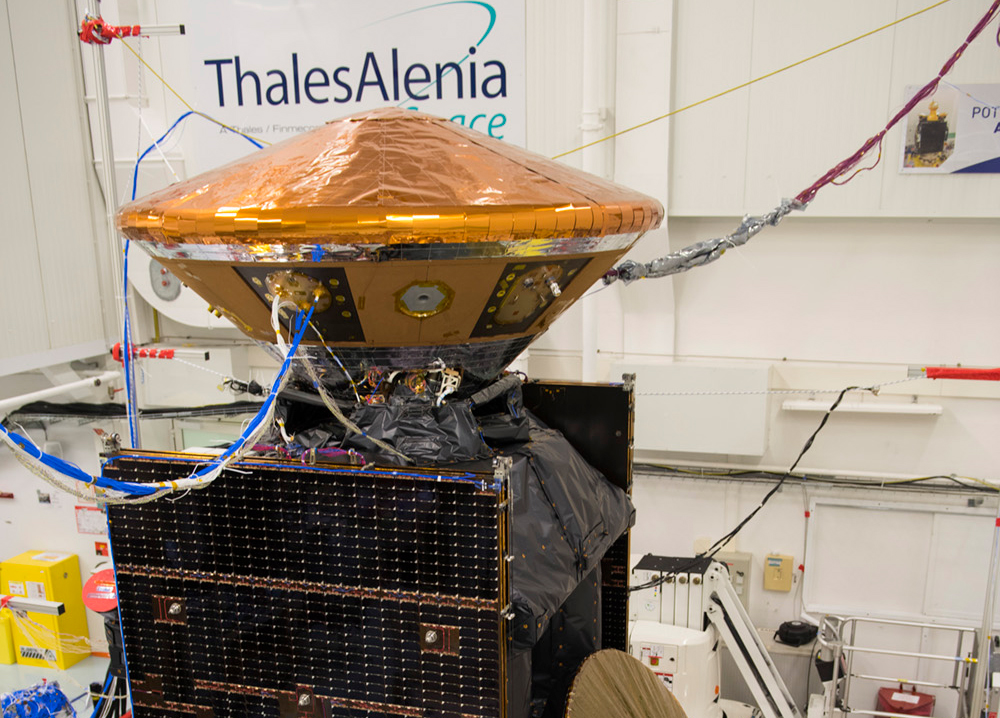
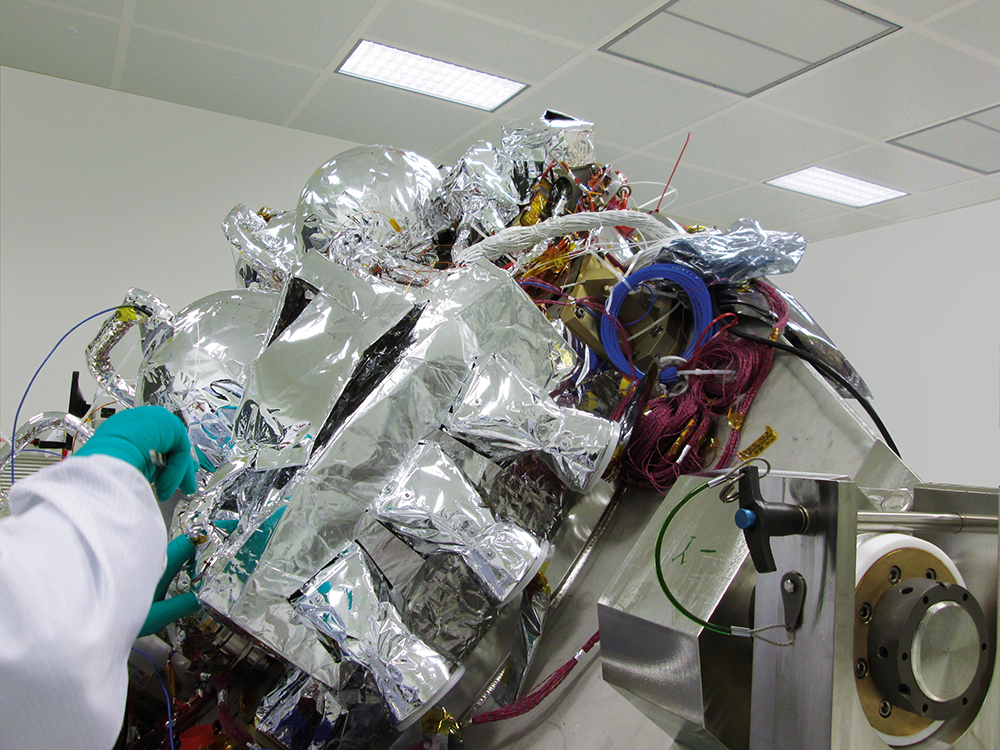
December 2015
Critical Thermal Protection made by Europe´s MLI-expert HPS in Portugal and Germany
Scientists, media and other VIP´s from Europe´s space sector took the last chance on November 25th in Cannes to have a look at ESA´s latest exploration technology before it lands on Mars in October, 2016: Schiaparelli – an entry, descent and landing demonstrator module – is a technology-testing vehicle carried by the ExoMars Trace Gas Orbiter to demonstrate the capability of European industry to perform a controlled landing on the surface of Mars. The preparation for this mission enhances Europe’s expertise and enables the testing of key technologies which could be used in subsequent missions to Mars.
Although designed to demonstrate entry, descent and landing technologies, Schiaparelli offers a science package that will operate on the surface of Mars for a short duration after landing, planned to last approximately 2-4 sols (martian days).
Schiaparelli will be protected during its decend to Mars at a speed of 21,000 km/h as well as during its operations on the surface against all thermal impacts by a multilayer insulation designed, developed and manufactured by the Portugese space company HPS Lda.
„Thermal protection is one of the critical components that decide about success or failure of any space mission. However, with Schiaparelli it opens yet another dimension of human space exploration, since this spacecraft has the task to verify technologies for the generations of unmanned and finally human missions to land on Mars in future,“ said Ernst K. Pfeiffer, CEO of HPS. „In addition, my teams in Germany and Portugal have developed also the thermal protection for this mission´s scientific instruments CASSIS and NOMAD. All HPS employees in Germany and Portugal are extremely proud to serve as Europe´s selected thermal protection specialists in space, to have soon more than 10kg hardware on Martian surface and to play with this a vital part in man´s historic pathfinding mission to other planets.“
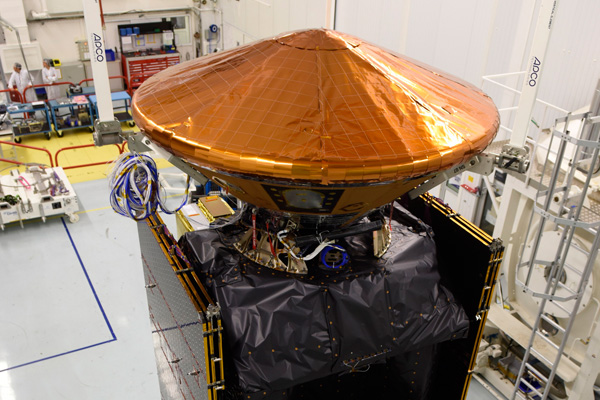
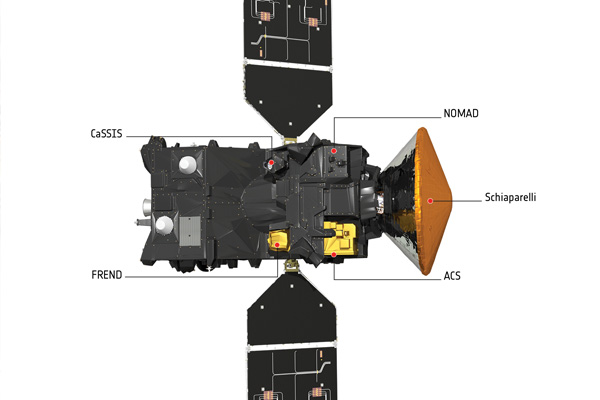
December 2015
Antenna Reflector Assembly For Mankind´s Mission to See Whether Nothing is As It Seems
When in the first quarter of the year 2020 a Soyuz launcher lifts off heading for space from the European spaceport in French Guiana it will carry a very precious payload: EUCLID, the satellite on the hunt for dark energy which is supposed to be the force behind the acceleration of the universe´s expansion. An invisible force, nevertheless dominating the universe to the extent of about 70 percent – as it seems, while matter we can see makes up for only about five percent of everything that we want to know.
Thales Alenia Space has been selected as ESA´s prime contractor for the spececraft, while Airbus Defence and Space provides the payload module. Due to the outstanding characteristics of high performance structures made by HPS in terms of RF-reflectivity, minimized mass as well as thermo-elastic distortions HPS was selected by TAS (Spain) on December 4th to provide the high gain antenna reflector structure, from which all high resolution pictures of that mission will be transmitted to Earth. The engineering center of the German space-SME in Munich will design, develop and test the product, will overlook the production of structures at INVENT GmbH, Braunschweig, of the multilayer-insulation (MLI) at its specialized subsidiary HPS lda. in Portugal, and of metal parts at SERENUM from the new ESA member-state Czech Republic.
Based on robust and intelligent technologies EUCLID will be stationed for six years at the Lagrange Point L2, 1,500,000 kilometers away from earth, on a mission to make us see beyond the seemingly.
